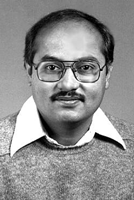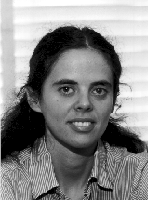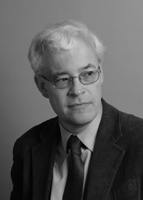Questions of Balance for SIAM Programs
April 11, 2007
Talk of the Society
James Crowley
It's the time of year when the U.S. National Academies (Sciences and Engin-eering) release the names of newly elected members. NAE, which goes first, added 64 members this year. Among them are several active members of the SIAM community, including P.R. Kumar, a professor in the Department of Electrical and Computer Engineering at the University of Illinois, Urbana�Champaign; �va Tardos, a professor of computer science at Cornell University; and Lloyd N. (Nick) Trefethen, a professor of numerical analysis at Oxford Univer-sity. Each of the three is a member of SIAM. Tardos, the editor-in-chief of SIAM Journal on Computing, received the Dantzig Prize at the 2006 annual meeting. Trefethen, whose extraresearch contributions to the community often take written form, including articles for this publication, is currently a member of the SIAM Board of Trustees. Kumar, whose current work is in control of wireless and sensor networks, gave an invited talk on the subject at a SIAM annual meeting a few years ago.
Others on the list with ties to SIAM include Leroy Hood, president of the Institute for Systems Biology, and John Tsitsiklis, a professor of electrical engineering and computer science at MIT. Hood was an invited speaker at this year's SIAM Conference on CS&E. (I confess to a failure to grasp what systems biology really is until I heard his talk.) Papers by Tsitsiklis, whose research is in the theory and application of optimization in dynamic and distributed systems, appear in SIAM journals (as it happens, his work is also mentioned in Barry Cipra's article).
We bring this news to the attention of readers mainly, of course, to offer congratulations to the newly elected members. It is indeed an honor to be selected and to join the other members of our community who are NAE members. But there is another reason as well.
The new members of NAE mentioned here are representative of SIAM in that they come from widely ranging departments: computer science, electrical engineering, numerical analysis, and biosciences. This being NAE, it's perhaps not surprising that no one is from a mathematics or applied mathematics department (each of which, of course, is the home of many SIAM members). The point is that the SIAM membership is highly diverse, with people from engineering disciplines, physics, biology, chemistry, as well as the mathematical sciences, computer science, compuational science. . . . This diversity is at the same time a strength and a challenge for SIAM.
The challenges arise---especially in the context of SIAM publications---in finding a good balance between mathematical/computational methods and applications in a wide range of domain sciences. Many in the SIAM community work as part of multidisciplinary teams, and papers describing their work often appear in publications in all the disciplines. We want good papers for our journals, with the emphasis on new computational methods, and algorithmic and modeling advances, but in the context of the scientific or engineering problem that has been solved. The SIAM Journals Subcommittee is now considering that goal and how we can best achieve it. I anticipate (and will report on) further discussions and debate on this issue in the SIAM Council and Board of Trustees.
Similar questions arise when it comes to structuring conferences in, say, computational science and engineering. Organizing committees work to attract sessions that include participants from application domains and to develop programs that promote interdisciplinary communication. At issue is whether SIAM should move toward a more structured approach in seeking to better promote multidisciplinary activities.
Comments are welcome ([email protected]).
***
By providing easy access to information, the Web is clearly facilitating the exchange of information across disciplinary boundaries. SIAM's approach to electronic publication has been to make the journals available to subscribing research institutions through campus-wide access via IP address. Like many other scientific societies, we have also been pursuing consortium arrangements---multi-institution subscriptions---for electronic access. Many of these consortia are in developing countries.
In another step toward openness, SIAM allows journal authors to post the final edited PDF versions of their papers on their home pages. SIAM retains the copyright, as set forth in the policy statement, which can be found at http://www.siam.org/journals/pdf/copyrite.pdf.
Making our journals widely accessible is consistent with our mission of promoting communication among researchers in the disciplines we serve. At the same time, however, we rely on institutional (for the most part university) subscriptions to underwrite our publishing program.
A healthy debate on these issues is under way across the scholarly publishing community. How can publishers provide wide (even completely open) access while preserving their viability (especially financial)? The SIAM Board of Trustees and its Financial Management Committee have been discussing these questions, and will certainly continue to do so for some time. The emergence of sophisticated search tools (like Google) brings these issues to a point. Finding information in the scholarly literature---whether through searches or through linked reference lists---is getting easier all the time. Researchers seeking specific papers or searching under particular authors can often find the papers they want. But a general Web search isn't always the answer: Not all papers can be accessed that way. And nonspecialists may need help in filtering the flood of information.
Even if we assume that search tools provide everything a user needs to obtain information, many issues remain. One is the archiving of information to ensure a complete record of the scholarly literature into the distant future; another is the question of citation. Yet another is peer review. The process of reviewing a paper, vetting the results, making corrections, and publishing an authoritative reviewed version is important to advancing scientific knowledge.
The discussions don't end with journals, of course. Google has a lofty goal of scanning all books in order to make the full text searchable. (See, for example, "Google's Moon Shot" by Jeffrey Toobin, The New Yorker, February 5, 2007.) Once a book has been scanned and is in a database, partial text could be displayed to give context to a search result, or the entire book could be displayed---if the publisher has given permission. Debates on appropriate boundaries for access to published material are taking place at a much higher level than SIAM, and in many cases the debates will unfold in court.
The open access debate is being conducted at the level of national and international governments. Drafted legislation that could go before the U.S. Congress would mandate that all papers published by authors working under government grants be deposited in a (government-run) database that is open to the public without charge. A majority of the papers published in SIAM journals by U.S. authors do cite funding by government grants.
Other proposals for open access---ensuring that all readers have free and instant access to the information on the Web---rely on fees paid by authors to have their papers published. Such models may work in disciplines in which authors are accustomed to paying page charges, or in which grants typically allow the researchers to charge publication fees against the grant. Neither is the case in the disciplines that SIAM represents.
The debate on open access is not uniquely American. The European Union and many of its member countries have been discussing these issues as well. (See "European Union Steps Back from Open Access Leap," Science, February 23, 2007, page 1065.)
As the Internet evolves, we will continue to need better ways to provide rapid and wide dissemination of the scientific literature while ensuring that publication of the scholarly literature continues to be financially feasible.



Elected to NAE in 2007 (top to bottom): P.R. Kumar, Franklin W. Woeltge Professor in the Department of the Department of Electrical and Computer Engineering at the University of Illinois, Urbana�Champaign, "for contributions to adaptive control, manufacturing systems, and wireless networks"; �va Tardos, professor in the Department of Computer Science at Cornell University, for "contributions to the design and analysis of efficient algorithms for network problems"; Nick Trefethen, professor of numerical analysis at the University of Oxford, "for contributions to stability theory in numerical analysis and its application to the determination of the onset of turbulence."

